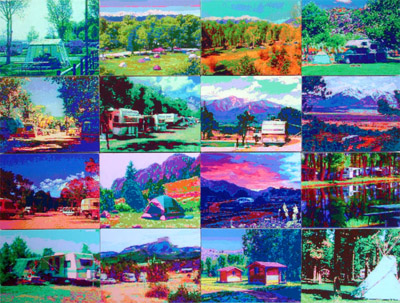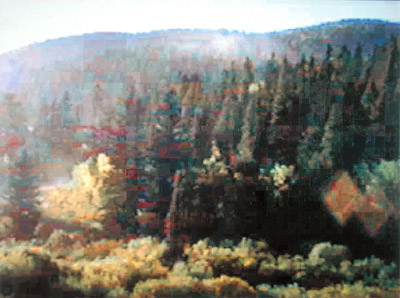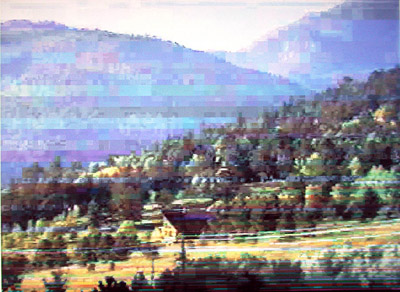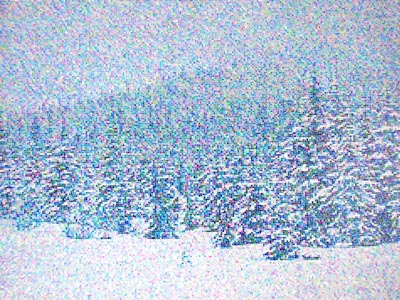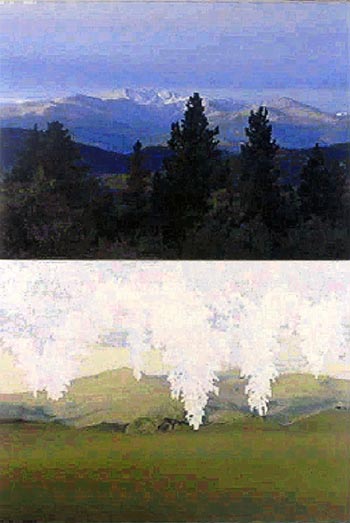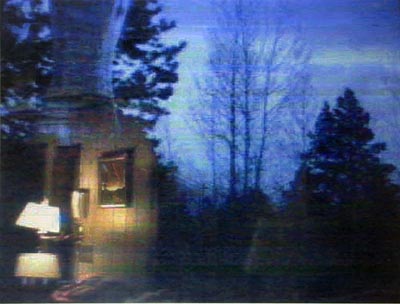The proliferation of digital photographs on the Internet is incomprehensibly vast. These images owe much to the categories and styles of traditional photography, yet often it is their unmediated low quality, in terms of selection, composition, and compression, which is particularly elevated to prominence by the new medium. The Internet represents a near infinite expansion of the mail-order catalogue, amateur snapshot or analogue video; a way of collecting visual information where the aesthetics of simple functionality or mediocrity is observed, as there is virtually no material cost involved.1 Photographers, filmmakers and painters have already trawled the found-image archive extensively. Gerhard Richter’s encyclopaedic Atlas project or the photographic collections of Fischli and Weiss are clear examples of the artistic imperative to gather, filter and categorise pictures. Trying to develop taxonomies of images is like assembling a Thesaurus, where it is possible to cross-reference through every definition. Now it would seem that found images are all we have thanks to the Internet’s primary function as consumer and diffuser of information, a generator of simulacra.2 Paradoxically, this infinite source seems to have more veracity due to its comprehensiveness and intimate humanity, at once both universal and local.
Digital images are two-dimensional matrices containing coded visual information. Until this data is interpreted for a screen or printer, they have no physical scale. They are immaterial, so the transformation into a picture is one of substantiation. It is, necessarily, a flawed process, moving from the virtual to the actual.
Painting reveals its method of manufacture on a human scale, imperfect and visible to the naked eye, creating a space for intimacy. What lies in between painting’s coordinates, the actuality of the surface and the illusory beyond, are suggestions of answers, the subjects of the picture: distractions from the terrible truth.3 Unwittingly or not, this is landscape painting’s primary concern: the representation of our relationship to the infinite. We view a painting from afar and see its effects and then approach closer and become intimate with the manner of production. We thus move from an appreciation of the deep space represented, and the relationships of forms, towards the abstract surface noise of paint, ironically finding ourselves further away from the depicted scene and the possibility of walking into it. This illusionism casts a spell over the viewer, caught in the reverie of appearance, disappearance and intimacy, physically moved, seduced and repelled.
The most vivid portrayal of this paradoxical space must be Guy Sherwin’s film-performance ‘Paper Landscape’ (1975/2003). Here, for one magical moment, we believe that the filmed protagonist (the artist himself), after slowly tearing away the paper screen obscuring the view, has transgressed the surface of the image and entered the great beyond, running into an English pastoral idyll, only to be shattered when the back-painted projection screen is slashed by the present day artist, bringing us back into our dislocated present. Sherwin’s work harks back to Cézanne, whose innovation was to deconstruct this dynamic, trying to represent the exact place where illusion and surface coincide in our comprehension of the pictured scene, opening up all the self-reflexivity of Modernism. Through the activation of the surface, literally and metaphorically, by way of expressive or mechanical application of paint and other materials, the artifice of painting is exposed, celebrating the partial, yet authentic, vision and gesture of the individual or their existential dissolution in the face of reproductive technology. Landscape paintings work by revealing the paradoxes of representation, true to a necessarily subjective view of our relationship to the world.4
In terms of landscape depiction, remote web-cameras seem to offer an extreme, possibly exemplary demonstration of the Internet’s promotion of the aesthetics of functionality. They are placed in the landscape simply to relay information, offering low-resolution telepresence and authenticity.5 Artistic notions of the picturesque do not come into the frame. Updated every few minutes or seconds, they spew out thousands of unique images every day, fleetingly existing on the phosphorescent screen of a computer monitor. They are occasionally glanced at before being superseded by a subsequent image, almost identical from a distance, and a completely new close up. They are representations of landscape free from painting’s history, so suggesting a more objective visualisation of the natural. Yet these pictures are not free of painterly qualities.
Digital photographs are generally compressed to limit the use of computer memory in storing files. Processing functions without regard to a hierarchy of forms on a human subjective level, or following any kind of natural order. This is akin to Modernism’s emblematic grid, operating as both a democratising and distancing agent.6 Areas of contrast are accentuated and colour is simplified, giving rise to accidental effects known as blocking artefacts, which produce surprising abstract forms, generating visual interest at the pixel level. This process is equivalent to the Impressionist imperative to capture the essence of a scene as quickly as possible with a restricted palette of colours, regarding the scene as a whole, employing brushstrokes of a similar size, and returning to the same view in different light conditions.7 This is a special relationship, where we can see digital photographs as proto-paintings, abstracting visual information, creating painterly effects several removes from the world. We can zoom into these images with a similar sense of wonder to the experience of approaching the surface of a painting, seeing how the illusion is generated. The agent for this is noise, a product of chaos and chance; the anomalies of disintegration and deterioration through flawed or mediated reproduction.
Entropy is a law of nature,8 and by working with the products of reproduction, the deteriorating remnants of images and other forms, we come closer to revealing the universal in a direct way, while retaining metaphorical and poetic resonances. ‘Imitating nature in her manner of operation’, as John Cage would put it. The incorporation of the results of flawed reproduction can be seen across all media. In film we could look at the found-footage materialist works of Birgit and Wilhelm Hein (‘Rohfilm’, 1968), or Malcolm Le Grice (‘Berlin Horse’, 1970). In painting, Robert Rauschenburg and Andy Warhol use screen-printing to reproduce low quality images from the popular media, accentuating the noise generated through the photomechanical process. Gerhard Richter salvages found photographs and through blurring incorporates them into the language of painting, promoting their atmospheric potentialities. The painters Robert Ryman and Christopher Wool exemplify the tradition of making something out of almost nothing: the generative powers of deterioration. It’s a kind of visual or aural composting, extending back to Kurt Schwitters and Charles Ives, and ultimately the allegories for the transience of existence of Dutch Vanitas painting.
Recent slide projection works by Anna Barriball (Untitled, 2006) show the emotional pull of such decomposition on familiar scenes. This is not only due to the violence of the distress of scratches on these found transparencies when scaled up, and the reminiscences and nostalgia that 35mm slides evoke, it is also that they become generic or archetypal in their appeal, more amenable to our projection into them exactly because information has been lost.
Digital photographs continue the processes of image deterioration in immaterial ways, introducing the noise of imperfect reproductive technology: inhuman, yet certainly imbued with the evocative sense of being unvalued or discarded. Crucially, it is the immaterial equivalence of all digital information, from the virtual infinity of the Internet down to the pixel or bit, via discrete objects and catalogues, that lends noise of mistakes in the collection and reproduction of sensory data equal value with the supposedly accurate depictive material. This offers a more simultaneous, ambiguous and three-dimensional convergence of the illusory and the surface.
The increasing sophistication of effects filters in image manipulation software, such as ‘watercolour’ and ‘film grain’, forms another unsettling link between photography and painting. Simulation carries through to canvas printing, and even robotic arms that emulate the painter’s expressive mark in real paint. Should the post-digital painter retreat into eclectic parody and stylistic whimsy, or turn simulation back on itself? Should the post-digital photographer try and stay within the traditional colour gamut or introduce fake film grain?
With the ubiquity of digital images in reproduction we can see that in terms of visual effect, there are strong associations and parallels between digital photography and painting in particular, virtually or physically drawing the viewer in to the mechanics of depiction. This runs counter to the perfect opposition between the forms on an existential level: perfect reproducibility, immateriality and potential immortality on the one hand, slowly realised, imperfect and unique physicality on the other. Julian Opie’s work is an unsettling and ambivalent response to the advances of simulation and digital technology: dehumanised and hermetically sealed in its icy celebration of synthetic materials. Yet the sublimation of entropic nature into the purity of empty signs is not the only way of regarding the advances of digital reproduction. We can also find meaning in the proliferation of flawed by-products of computational processes. Tim Head’s data projection ‘Treacherous Light’ (2002) exemplifies the immateriality and infinite potentiality of digital images. Each pixel of the large projection independently displays a random colour from a palette of millions. Refreshed several times a second, the completely abstract noise of colour seems to generate form as it is approached. This is simply the brain trying to distinguish pattern from this chaos. It is an invitation to dive into the Sea of Solaris where hallucinations become manifest.9
The relationship of photography and painting has become more fluid and complementary thanks to digital photography. Through image compression and paint simulation, a profound reverence for painting is manifested, even if this is cold and robotic, stemming from functionality or acquisitiveness. It seems essential, if ultimately futile, to answer these advances by entering into a creative dialogue; to examine painting in the light of digital reproduction in an attempt to claim back for our perception authentic and transitory landscapes from the parallel wilderness of the Internet.10
The double nature of painting, illusionism and materiality, is a perfect field in which to explore the duality of perfect resemblance and absolute chaos engendered by entropy and its digital negation or simulation. For we are lost to the garden, removed from nature, and painting operates as a technique to reconnect to the primal, a way of transforming representations back into physical objects.
Notes
1. The super-abundance of information in reproduction is repeated in other media, like text, moving images, and sound. Hopefully, questions of veracity, originality, and human agency are thrown up in similar ways to this discussion, which focuses on the relationship of digital photography and simulation to painting in particular.
2. See Baudrillard (1994: 1-7)
3. ‘The simulacrum is never what hides the truth – it is truth that hides the fact there is none. The simulacrum is true.’ – Ecclesiastes (cited by Baudrillard, 1994: 1)
4. ‘To inquire adequately into the power of landscape painting, we will need to explore and to re-examine critically the kinds of metaphors for which the genre has historically furnished occasions and to which it has given rise – among them metaphors of integration and dislocation, of presence and absence.’ (Harrison, 1994:231)
5. ‘It is difficult, if not impossible, to determine with certainty which webcameras are conveying accurate visual information, and which are frauds passing off still images or a Quicktime movie as just-captured reality.’ See Campanella (2002: 264-76)
6. ‘In the spatial sense, the grid states the autonomy of the realm of art. Flattened, geometricized, ordered, it is antinatural, antimimetic, antireal. It is what art looks like when it turns its back on nature.'(Krauss (1985: 9)
7. See Jules Laforgue’s formulation of the ‘Impressionist eye’ – ‘a natural eye forgets tactile illusions and their convenient dead language of line, and acts only in its faculty of prismatic sensibility.’ (Laforgue, 1998: 936-41)
8. Newton’s second law of thermodynamics. Thanks to Paul Hegarty (editor) for these important caveats: ‘Entropy can at least be held at bay: the scientist Erwin Schrödinger (of cat fame) said life was able to create a temporary but lengthy ‘negative entropy’. Not all science agrees on the inevitability of entropy (i.e. since discoveries of dark matter, dark energy), and Newtonian physics works at some levels, but not all…’ Indeed, life can be seen as an instance of maintaining the products of chance and evolutionary success encoded in DNA, and the study of the genome has revealed that a large proportion of chromosome code turns out to be ‘noise’, or at least functionless information, stuff that is left after millions of adaptations. So the propagation and continuation of life depends on flawed reproduction. It’s tempting to consider the practice of art making as a distillation of this ‘negative entropy’. In terms of questioning the ultimate inevitability of entropy on an astronomic or subatomic scale, this has little relevance to human subjectivity, although it is certainly imperative to examine (our) nature in the light of technological developments such as artificial intelligence and genetic engineering. Marc Quinn’s frozen vase of flowers ‘Eternal Spring’, 1998, offers a cryogenic challenge to the inevitability of decay, although it in fact speaks most poignantly about human vanity in the light of technological approaches to notional immortality.
9. See Stanislaw Lem’s novel Solaris (1961), or Andrei Tarkovsky’s film of it (1972).
10. Since 2000 I have been making paintings based on images from the website of another Dan Hays who lives in the Rocky Mountains of Colorado (with his permission). A simple awareness of the associations of digital images and Impressionism has grown in complexity as the project has progressed, introducing references to the romantic landscapes of the Hudson River School, American Transcendentalism, cryptic responses to American foreign policy, extending my source material out to Internet imagery from across the whole state of Colorado, it being essential that I have never physically visited what has become a mythic place. Increasingly, it is the flawed nature of painted reproduction, both intentional and unintentional, that I have come to regard as crucial to my work, only half-jokingly considering myself a very slow and low quality printer. This culminated in a touring exhibition in 2006, organised by Southampton City Gallery titled ‘Impressions of Colorado’. This essay inevitably forms a self-serving justification for my own artistic practice. I only hope that the reader can look beyond this indulgence and find wider implications of the effect of digital reproduction in an appreciation of the mechanics of painting and representation in general, both optically and metaphorically.
References
Baudrillard, J. (1994) Simulacra and Simulation. Trans. S. Faria Glaser. Ann Arbor, MI.: University of Michigan Press.
Harrison, C. (1994) ‘The Effects of Landscape’ in Landscape and Power. Chicago: University of Chicago Press.
Campanella, T. J. (2002) ‘Eden By Wire: Webcameras and the Telepresent Landscape’ in N. Mirzoeff (ed.) A Visual Culture Reader. London. Routledge.
Krauss, R. (1985) The Originality of the Avant-garde and Other Popular Myths. Cambridge, MA.: MIT Press.
Laforgue, J. (1998) ‘Impressionism’ in C. Harrison et al. (eds.) Art in Theory 1815-1900. 936-41.
Images by Dan Hays
